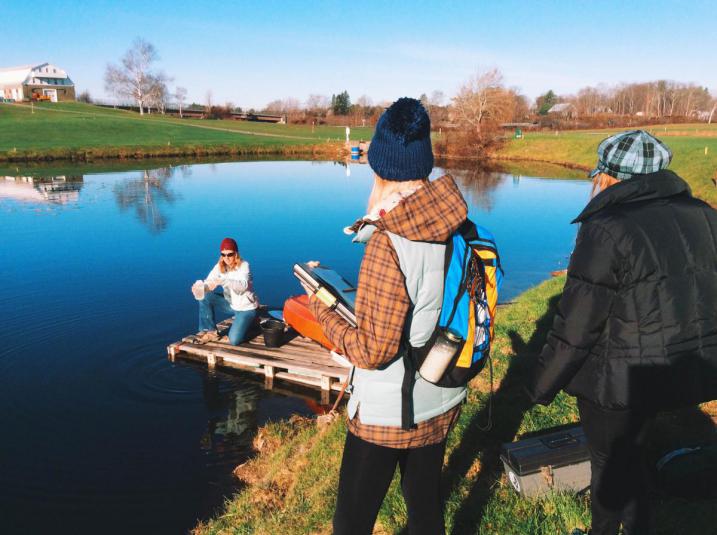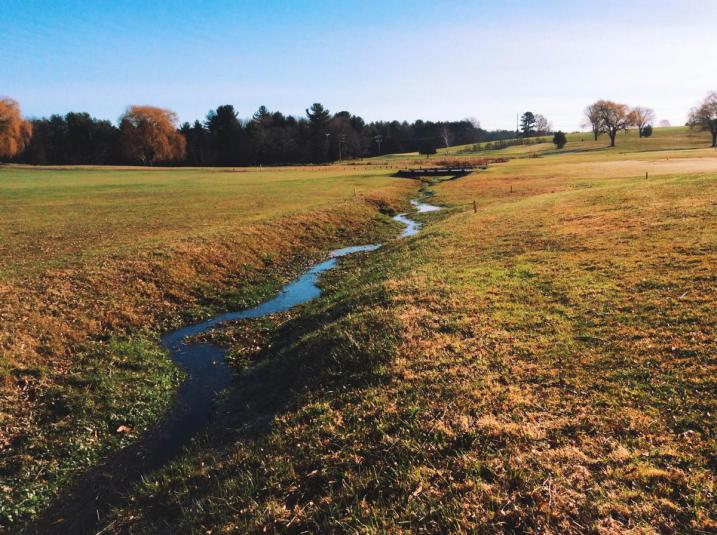News from the Field: A Day with the Coastal Research Volunteers

When it comes to Citizen Science, I am a newbie. I never shied away from science as a child, but when I got a little older I found my passion was people, cultures, and communities rather than bugs or space or microorganisms or the like. The good news is you don’t have to have a science background to do citizen science. Everyone can do it!
Last Wednesday morning I got my first chance to do just that. I dusted off my sixth grade science knowledge, formerly lost in the deep dark corners of my brain, to observe and help with a water quality monitoring project at Sagamore-Hampton Golf Club in North Hampton, NH. We tested Cornelius Brook, which weaves its way around the fairways and forest at the golf club.

Leading the charge was Alyson Eberhardt, who coordinates the Coastal Research Volunteers (CRV), a group of citizen science volunteers who work with coastal researchers on a variety of interesting projects. Joining us were Alyson’s colleague, Rebecca Zeiber, and two trusty volunteers, Molly and Brittany.
We measured four different parameters in the field, as well as collected water samples to be processed in a laboratory. We looked at the pH of the water, the temperature, dissolved oxygen levels, and conductivity. The pH of the water in one spot we tested was a little basic. I thought, “Hmm… is there something too simple about this water?” That sounded funny so I asked Alyson what she meant by basic. She explained, “That means the water pH was a little higher than a neutral pH.” The tumbleweeds in my science brain slowly started to clear away and I remembered that some solutions are acids and others are bases (hence, basic!). There are no silly questions when it comes to citizen science!
As for the conductivity of the water, I learned that is the ability for the water to conduct an electric charge, which is affected by bedrock, storm water runoff, and other factors. The dissolved oxygen levels are a good indicator of the health of the water for living things like fish.

We continued to test the water and collect samples at four different points along Cornelius Brook and a small irrigation pond. Our sampling was part of a larger ongoing project between NH Sea Grant/UNHCE and the Sagamore-Hampton Golf Club to assess the stream health at Sagamore, to understand the conditions over time, and to evaluate the effectiveness of the environmentally friendly strategies that the club is using to maintain the golf course. Cornelius Brook is a headwater stream of the Winnicut River, which discharges into Great Bay

In addition to monitoring water quality, Alyson and her team of volunteers are creating riparian buffers for the stream throughout the golf course. Since the Great Bay is an impaired water body for nitrgoen, this project has unique importance for the region. Just recently the CRV came out to Sagamore to plant some pollinator habitat gardens – both good for pollinators like butterflies and bees and for helping to filter any sediment and nutrients coming off the surrounding land whenever it rains. They planted over 500 plants so far that will showcase a range in color and will bloom across the seasons from summer to fall. This is not only better for the bugs, but nicer on the eyes for people who recreate at Sagamore!

Over the course of this past year many golfers have seen this motley crew of volunteers traipsing along with their buckets and coolers filled with samples and handy devices for measuring water quality. They’ve lugged plants and seeds to newly tilled land filled with scrumptious compost.
Muddy boots and colorful fleeces stand out like a sore thumb against the typical golfer attire, but Alyson mentioned that golfers are usually very interested and excited to learn about the project when they stop her to chat. The Sagamore-Hampton Golf Club doesn’t just have an ecosystem of wildlife and streams… it has an ecosystem of people! It just goes to show we can all come together to help the environment no matter what our backgrounds: business owners and golfers, science professionals like Alyson, and citizen science volunteers like Molly, Brittany, and myself.

Are you interested in learning more about citizen science and stewardship opportunities with the Coastal Research Volunteers? Click here to visit their website, or contact Alyson Eberhardt at alyson.eberhardt@unh.edu.